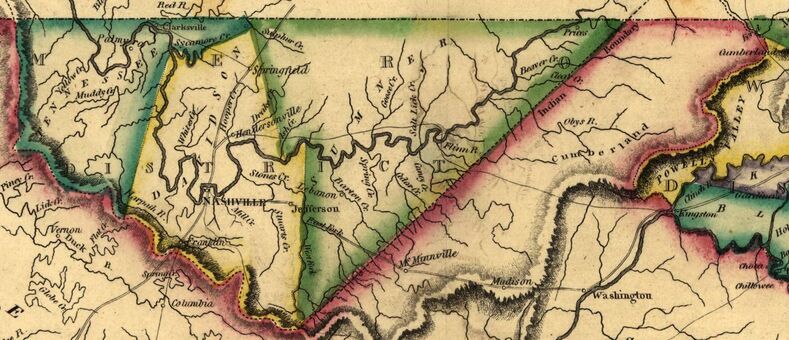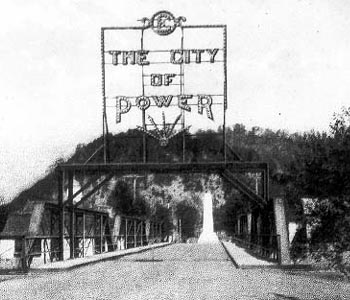|
Cumberland Compact
{{Short description, 1780 document establishing the law of settlers in present-day Tennessee The Cumberland Compact was both based on the earlier Articles of the Watauga Association composed at present day Elizabethton, Tennessee and is a foundation document of the Tennessee State Constitution. Signed on May 13, 1780, by early settlers led to the Cumberland River area by James Robertson and John Donelson, where they settled Fort Nashborough, which would later become Nashville, Tennessee. The only surviving copy of the Cumberland Compact was discovered in 1846 inside a trunk that once belonged to early pioneer and founder Colonel Samuel Barton. The copy in the Tennessee State Archives is slightly damaged. Other than this the document is intact and legible. The Cumberland Compact was composed and signed by 256 colonists. One colonist, James Patrick of Virginia, was illiterate and marked his name with an "X". This constitution called for a governing council of 12 judges who w ... [...More Info...] [...Related Items...] OR: [Wikipedia] [Google] [Baidu] |
Watauga Association
The Watauga Association (sometimes referred to as the Republic of Watauga) was a semi-autonomous government created in 1772 by frontier settlers living along the Watauga River in what is now Elizabethton, Tennessee. Although it lasted only a few years, the Watauga Association provided a basis for what later developed into the state of Tennessee and likely influenced other western frontier governments in the trans-Appalachian region. North Carolina annexed the Watauga settlement area, by then known as the Washington District, in November 1776. Within a year, the area was placed under a county government, becoming Washington County, North Carolina, in November 1777.Samuel Cole Williams, ''William Tatham, Wataugan'' (Johnson City, Tenn.: The Watauga Press, 1947), pp. 11–28. This area covers the present day Washington County, Carter County, and other areas now located in the northeast part of the state of Tennessee. While there is no evidence that the Watauga Association ever cl ... [...More Info...] [...Related Items...] OR: [Wikipedia] [Google] [Baidu] |
Davidson County, Tennessee
Davidson County is a county in the U.S. state of Tennessee. It is located in the heart of Middle Tennessee. As of the 2020 census, the population was 715,884, making it the second most populous county in Tennessee. Its county seat is Nashville, the state capital and largest city. Since 1963, the city of Nashville and Davidson County have had a consolidated government called the "Metropolitan Government of Nashville and Davidson County", commonly referred to as "Metro Nashville" or "Metro". Davidson County has the largest population in the 13-county Nashville-Davidson–Murfreesboro– Franklin Metropolitan Statistical Area, the state's most populous metropolitan area. Nashville has always been the region's center of commerce, industry, transportation, and culture, but it did not become the capital of Tennessee until 1827 and did not gain permanent capital status until 1843. History Davidson County is the oldest county in the 41-county region of Middle Tennessee. It dates ... [...More Info...] [...Related Items...] OR: [Wikipedia] [Google] [Baidu] |
History Of Nashville, Tennessee
This article pertains to the history of Nashville, the state capital of Tennessee. Native Americans had not lived in the area in the century before a frontier post of Fort Nashborough was built here in 1779 by pioneers from North Carolina. In 1784 it was incorporated as a town by the North Carolina legislature; it became a city in 1806. In 1843 it became the state capital. In the Civil War Nashville was seized by Federal troops in 1862 and became a major Union military base. Confederate General J. B. Hood was decisively defeated in the Battle of Nashville in 1864. The city became the political, transportation, business and cultural center of the Middle Tennessee region. Besides the state government, it is best known for its educational, musical and religious establishments. In 1963 Nashville and Davidson County were consolidated under a single charter and are administered by a mayor and a council. Prehistory The first known settlers in the area of modern Nashville were Nativ ... [...More Info...] [...Related Items...] OR: [Wikipedia] [Google] [Baidu] |
Legal History Of Tennessee
Law is a set of rules that are created and are enforceable by social or governmental institutions to regulate behavior,Robertson, ''Crimes against humanity'', 90. with its precise definition a matter of longstanding debate. It has been variously described as a science and as the art of justice. State-enforced laws can be made by a group legislature or by a single legislator, resulting in statutes; by the executive through decrees and regulations; or established by judges through precedent, usually in common law jurisdictions. Private individuals may create legally binding contracts, including arbitration agreements that adopt alternative ways of resolving disputes to standard court litigation. The creation of laws themselves may be influenced by a constitution, written or tacit, and the rights encoded therein. The law shapes politics, economics, history and society in various ways and serves as a mediator of relations between people. Legal systems vary between jurisdiction ... [...More Info...] [...Related Items...] OR: [Wikipedia] [Google] [Baidu] |
Frederick Stump House
The Frederick Stump Tavern-Inn is a historic house in Nashville, Tennessee, USA. It was built by Colonel Frederick Stump, an early settler of Nashville who arrived in the region as part of the first group of white settlers at Fort Nashboro in 1779. It has been listed on the National Register of Historic Places since April 2, 1973. The two-story building is constructed of red cedar logs and has eight rooms, including two sleeping rooms on the upper floor and one on the bottom floor. It originally sat closer to the road, but was moved back approximately 100 feet when Buena Vista Pike was widened. The structure is directly down the street from the Alexander Ewing House, another listed historic building constructed in 1821 that sits approximately 850 feet to the north of the Stump House. Frederick Stump Frederick Stump was born circa 1724. In Pennsylvania by the 1760s he was known to be aggressive in Native American territory. In January 1768, he killed or helped to kill ten native ... [...More Info...] [...Related Items...] OR: [Wikipedia] [Google] [Baidu] |
James Robertson (early American)
James Robertson (June 28, 1742 – September 1, 1814) was an American explorer, soldier and Indian agent, and one of the founding fathers of what became the State of Tennessee. An early companion of explorer Daniel Boone, Robertson helped establish the Watauga Association in the early 1770s, and to defend Fort Watauga from an attack by Cherokee in 1776. In 1779, he co-founded what is now Nashville, and was instrumental in the settlement of Middle Tennessee. He served as a brigadier general in the Southwest Territory militia in the early 1790s, and as an Indian Commissioner in later life. Early life and education Robertson was born in 1742 in Brunswick County, Virginia, of Scots-Irish and English descent. Around 1749, his father relocated the family to Wake County, North Carolina. Robertson worked with his siblings on their family farm and had limited formal education, but he learned to track and hunt animals and know his way in the woods and waterways. Marria ... [...More Info...] [...Related Items...] OR: [Wikipedia] [Google] [Baidu] |
John Montgomery (pioneer)
Lieutenant Colonel John Montgomery (c. 1750–1794) was an American soldier, settler and explorer. He is credited with founding the city of Clarksville, Tennessee. Montgomery County, Tennessee is named after him. Life In 1771, Montgomery first entered the area of the Cumberland River. Much was learned in the expedition, but Native Americans forced the explorers back to Virginia. In 1775, Montgomery was one of the signers of the Fincastle Resolutions, the earliest statement of armed resistance to the British Crown in the American Colonies. During the American Revolutionary War, Montgomery served initially as a captain and finally as a lieutenant colonel under the command of Brigadier General George Rogers Clark during his Illinois campaign. Under Clark's orders, Montgomery led an expedition against several Indian tribes to prevent the British from organizing them to attack Kentucky. For the remainder of war, he ran supplies between New Orleans and Clark's army in the north. Mon ... [...More Info...] [...Related Items...] OR: [Wikipedia] [Google] [Baidu] |
Kasper Mansker
Kasper Mansker or Casper Mansker also, spelled Mäintzger and Minsker (1750–1820) was a longhunter and one of Middle Tennessee's first European explorers and settlers. Early life Kasper Mansker was born on the European immigrant ship, ''Christian'', bound for the New World, in 1750. The Mansker family, possibly, came from Merchingen, Merzig-Wadern, Kreis District, Saarland, Germany, where the name is common. His parents, Ludwig Mäintzger and Maria Esch, were German immigrants, who settled in the British American colonies, but due to poor recordkeeping there are vague and conflicting reports about exactly where they lived. Mansker had four brothers, John, George, Sr., and Ludwig and one sister, Catherine. Kasper Mansker probably lived in the mid-Atlantic region of the American thirteen colonies. Various reports mentioned the whereabouts of Mansker in Pennsylvania, Virginia, and in what is now West Virginia. However, Mansker soon ventured west to explore the vast lands beyond ... [...More Info...] [...Related Items...] OR: [Wikipedia] [Google] [Baidu] |
Bushong
Bushong is a surname found mostly in the United States, derived from the surname Boschung found mainly in Switzerland, but also in the Palatinate and other regions in Western Europe. Surname history The American surname, ''Bushong'' and variant ''Bushon'', prior to being ''anglicized'', was the German-Swiss name, ''Boschung''. The spelling was changed after immigration to Colonial America. The immigrants, Hans and Johann Nicholas both arrived as Boschung, Hans in 1731 and Johann Nicholas in 1732. The original ships manifests and transcriptions list them as Boschung, but the spelling was changed in their American lives.A Collection of Upwards of Thirty Thousand Names of German, Swiss, Dutch, French and Other Immigrants in Pe ... [...More Info...] [...Related Items...] OR: [Wikipedia] [Google] [Baidu] |
Philip Alston (counterfeiter)
Philip Alston (Feb. 18, 1740 or 1741 – after 1799) was an 18th-century Spanish-American counterfeiter, both before and after the American Revolution. He operated in Virginia and the Carolinas before the war, and in Kentucky and Illinois afterward. He was associated with Cave-in-Rock and his son, outlaw Peter Alston, and counterfeiter John Duff. He was an early American settler in Natchez, as well as in the Cumberland and Red River valleys in Kentucky and Tennessee. Early life in South Carolina, North Carolina, and Virginia Philip Alston was born Feb. 18, 1740 or 1741, the son of Solomon Alston and Sarah Ann "Nancy" Hinton. He had at least one brother named John. Alston was probably born in the British Royal colony of the Province of South Carolina, where the Alston family first settled in North America. The Alston surname was very common in this colony. His family moved to the Province of North Carolina when he was quite young. Alston was believed to have married in 1765 ... [...More Info...] [...Related Items...] OR: [Wikipedia] [Google] [Baidu] |
Andrew Jackson
Andrew Jackson (March 15, 1767 – June 8, 1845) was an American lawyer, planter, general, and statesman who served as the seventh president of the United States from 1829 to 1837. Before being elected to the presidency, he gained fame as a general in the United States Army and served in both houses of the U.S. Congress. Although often praised as an advocate for ordinary Americans and for his work in preserving the union of states, Jackson has also been criticized for his racial policies, particularly his treatment of Native Americans. Jackson was born in the colonial Carolinas before the American Revolutionary War. He became a frontier lawyer and married Rachel Donelson Robards. He served briefly in the United States House of Representatives and the United States Senate, representing Tennessee. After resigning, he served as a justice on the Tennessee Supreme Court from 1798 until 1804. Jackson purchased a property later known as the Hermitage, becoming a wealth ... [...More Info...] [...Related Items...] OR: [Wikipedia] [Google] [Baidu] |
Elizabethton, Tennessee
Elizabethton is a city in, and the county seat of Carter County, Tennessee, United States. Elizabethton is the historical site of the first independent American government (known as the Watauga Association, created in 1772) located west of both the Eastern Continental Divide and the original Thirteen Colonies. The city is also the historical site of the Transylvania Purchase (1775), a major muster site during the American Revolutionary War for both the Battle of Musgrove Mill (1780) and the Battle of Kings Mountain (1780). It was within the secessionist North Carolina "State of Franklin" territory (1784–1788). The population of Elizabethton was enumerated at 14,176 during the 2010 census. Geography Northeast Tennessee location Elizabethton is located within the "Tri-Cities" area (encompassed by Bristol, Johnson City, and Kingsport) of northeast Tennessee. Time offset from Coordinated Universal Time (UTC): UTC-5 (Eastern Time). According to the United States Census Bu ... [...More Info...] [...Related Items...] OR: [Wikipedia] [Google] [Baidu] |








